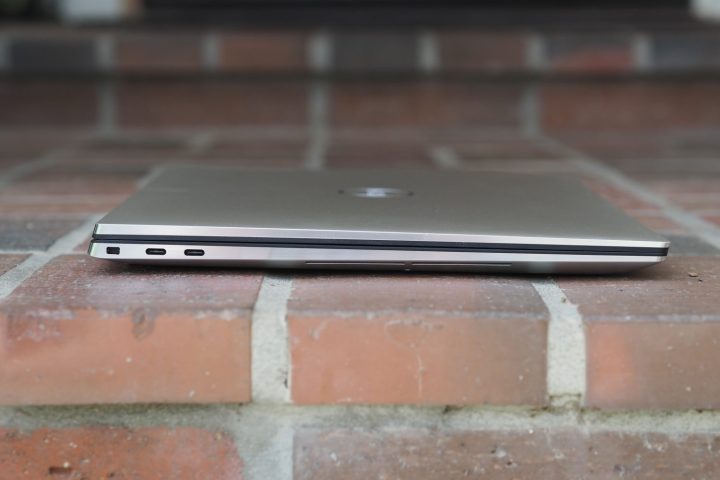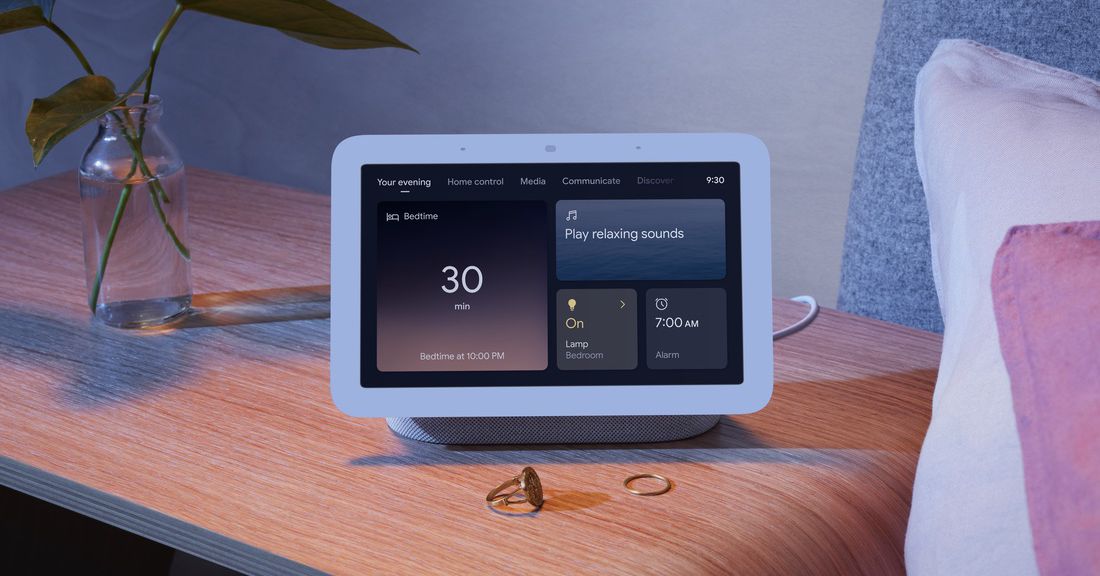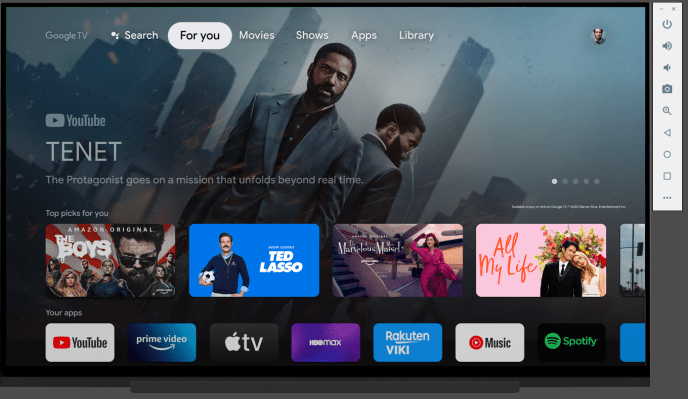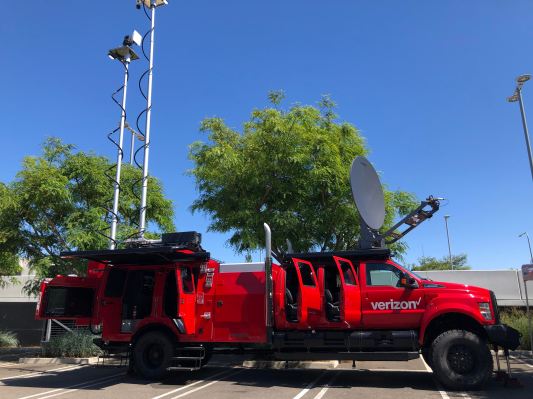Dell XPS 17 (9720) review: Almost all the right improvements
The Dell XPS 17 9720 retains all the best qualities of its predecessor while upgrading to 12th-gen Intel CPUs.
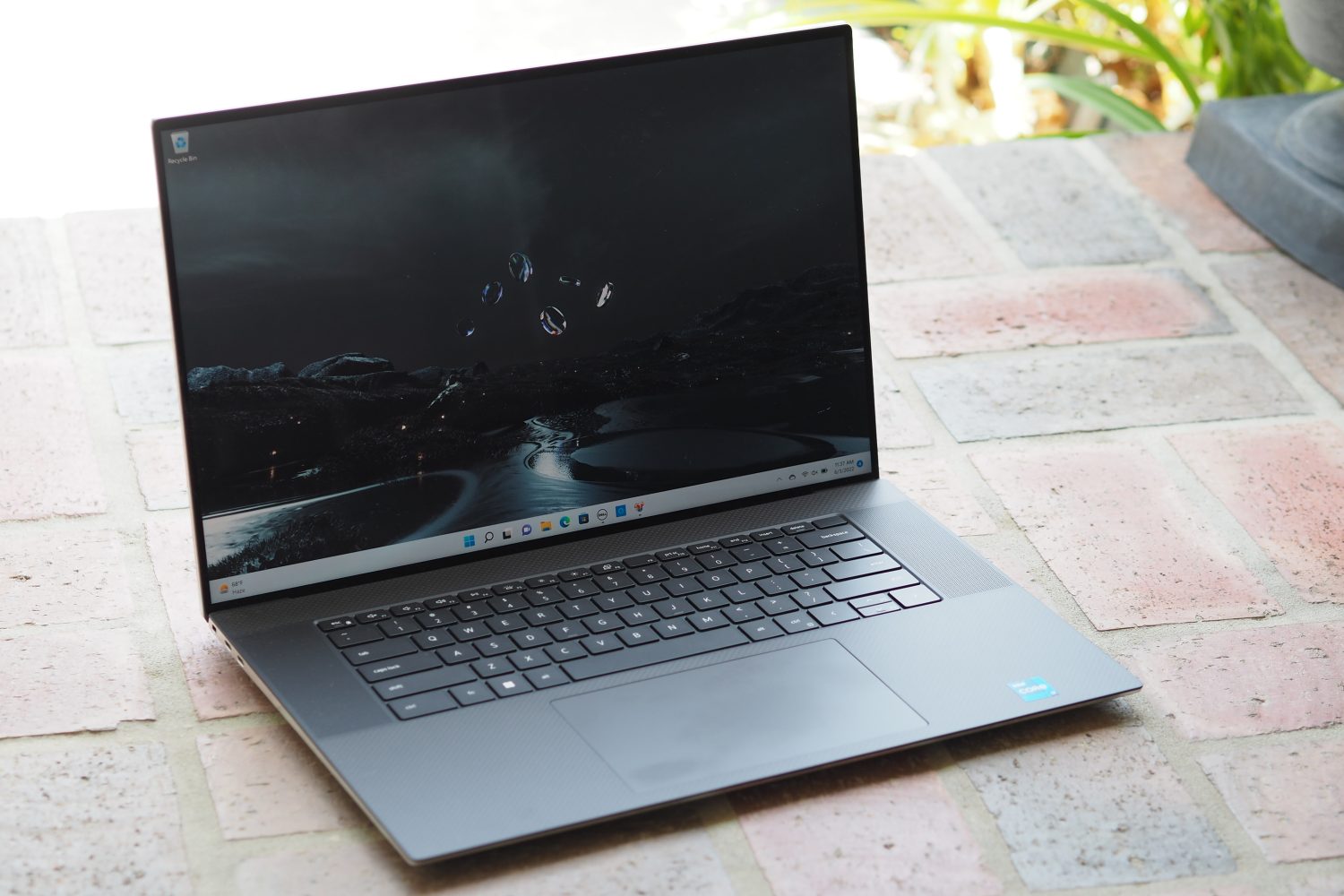

Dell XPS 17 (9720)
MSRP $3,039.00
Pros
Outstanding build quality Streamlined good looks Thin and light Excellent productivity and creative performance Solid midrange gaming performance Superior IPS display Great keyboard and touchpadCons
Expensive Limited collection of ports Some thermal throttlingDell’s XPS 17 holds spots on our lists of best laptops and best 17-inch laptops, and it’s not a surprise. It’s an incredibly well-built laptop with an expansive display that’s bright and colorful, and it provides solid performance for a 17-inch machine that’s about as small as it can be. The XPS 17 (9270) upgrades to Intel’s 12th-gen CPUs and DDR5 RAM, and the webcam and infrared camera are split apart for better video quality. Otherwise, everything that was great about the XPS 17 9710 remains in place.
I reviewed a midrange configuration of the XPS 17 (9720), with the Intel 12th-gen Core i7-12700H CPU, a UHD+ (3,840 x 2,400) IPS display, and the Nvidia RTX 3060 GPU. If you’re looking for a large laptop that’s still reasonably sized with solid performance, then the XPS 17 (9720) delivers.
Design
 Mark Coppock/Digital Trends
Mark Coppock/Digital TrendsThe XPS 17 (9720)’s design is unchanged from the previous version, the XPS 17 (9710). It retains the same incredibly solid chassis, with CNC-machined aluminum in the lid and bottom chassis and black carbon-fiber lining the keyboard deck.
It’s as comfortable as always, with the carbon fiber providing some warmth compared to bare metal. Few laptops can rival the XPS 17 in its build quality, but some that do include Dell’s XPS 15 and Apple’s MacBook Pro lineup. The hinge benefits from the same dual-clutch design as the rest of the XPS lineup, and it can be opened with one hand while the display remains firmly in place.
The aesthetic has also been perfected over several generations, and the XPS 17 looks just like the XPS 15 and the XPS 13, only larger. It enjoys the same streamlined chassis with sleek and sophisticated angles. The two-tone effect afforded by the silver aluminum and black carbon fiber is striking, and the double-anodized chrome on the sides protects from scratches and looks great. The Razor Blade 17 is also an elegant machine, but it’s a more minimalistic design. I like the XPS 17’s aesthetic quite a bit and struggle to think of a better-looking 17-inch laptop.
The XPS 17 has some of the smallest display bezels available on a laptop.
Like the rest of the XPS line, the XPS 17 has some of the smallest display bezels available on a laptop today, with an impressive 93.7% screen-to-body ratio. That makes for a narrower and shallower chassis than most 17-inch laptops, but not necessarily a thinner one. The MSI Creator Z17, for example, is wider and deeper than the XPS 17 with the same size 17-inch 16:10 display, and it’s thinner at 0.75 inches compared to 0.77 inches while being heavier at 6.79 pounds versus 5.34 pounds.
The Razer Blade 17 has a 17.3-inch 16:9 display and is again wider and deeper than the XPS 17, while it’s slightly thicker at 0.78 inches and heavier at 5.5 pounds. Even the LG Gram 17, which is incredibly thin at 0.70 inches and light at 2.98 pounds, is still slightly wider and deeper than the XPS 17 without offering a high-speed CPU or GPU. There aren’t many mainstream 17-inch laptops to compare with, as most laptops at this size are either gaming laptops or portable workstations and tend to be larger, thicker, and heavier.
Connectivity is quite limited compared to other 17-inch laptops. You get four USB-C ports with Thunderbolt 4 support, a 3.5mm audio jack, and a full-size SD card reader. The MSI Creator Z17 is thinner, and yet it packs in HDMI and USB-A ports. Dell does throw in a USB-C to HDMI and USB-A adapter, but the lack of legacy ports on the laptop itself is disappointing.
However, wireless connectivity is fully up to date with Wi-Fi 6E and Bluetooth 5.2.
Performance

While the design of the XPS 17 (9720) is the same as the previous generation, the engine driving the laptop has been brought up to date with Intel’s 12th-gen CPUs, DDR5 RAM, and PCIe 4.0 solid-state drives (SSDs). My review unit featured the Core i7-12700H, a 14-core (six performance and eight efficient), 20-thread 45-watt chip that’s been a strong performer in laptops we’ve reviewed. You can configure the XPS 17 with up to the faster-clocked Core i9-12900HK, although, as we’ll see, there may not be much value in doing so given the XPS 17’s thin chassis.
Dell includes its utility to adjust the fan and CPU speeds for quiet, balanced (Optimized), and performance (Ultra Performance) modes. I ran the benchmarks in both balanced and performance modes and reported both in the table below. Where available, I also reported both scores for the comparison machines. The XPS 17’s performance mode wasn’t as impactful as on some other laptops, including the XPS 15 that I recently reviewed, with one expectation that I’ll get to shortly.
Overall, performance was solid and a significant increase from the XPS 17. Geekbench 5 was the most significant change, with the new model scoring a whopping 50% increase. We didn’t record our Handbrake test for the XPS 17 9710, a test that encodes a 420MB video as H.265 and is CPU-intensive. In Cinebench R23, another CPU-intensive benchmark, the XPS 17 was 25% faster in balanced mode. In the PCMark 10 Complete benchmark that tests a variety of productivity, multimedia, and creative tasks, the XPS 17 was 15% faster. Performance mode tends to make little difference in this test on any machine.
Compared to the MSI Creator Z17 and the Razer Blade 17 (with the slightly faster Core i7-12800H), the XPS 17 was competitive across the board. These are all thin laptops, so I threw in the MSI GE76 Raider gaming laptop to give an idea of what a faster CPU and thicker chassis (hence, better thermals) can do. That machine was considerably faster in the Cinebench test, but close to the XPS 17 in the rest of these benchmarks.
Next, I used the Pugetbench for Premiere Pro benchmark, which runs in a live version of Adobe Premiere Pro and provides a real-world indication of creative performance while demonstrating the impact of a discrete GPU. We used an older version of Pugetbench to test the XPS 17 (9710) and can’t directly compare results with the XPS 17 (9720).
Dell paid a great deal of attention to thermal design, but physics still wins out.
In the latest version, the XPS 17 9720 scored 771 in balanced mode and 853 in performance mode — making Pugetbench the one benchmark where performance mode was effective. That compares to the MSI Creator Z17 with a faster RTX 3070 Ti at 897 in balanced mode and 957 in performance mode. The Razer Blade 17 with an RTX 3080 Ti scored 969 in performance mode, and the MSI GE76 Raider also with an RTX 3070 Ti scored 1,120. The XPS 17 9270 did well in this benchmark given its lower-end GPU and thin chassis.
Speaking of a thin chassis, Dell paid a great deal of attention to thermal design with the XPS 17 9720, but physics still wins out. There was some throttling in our most CPU-intensive benchmarks, with the CPU periodically hitting 100 degrees Celsius and then dropping down into the 80s. The throttling wasn’t constant, though, and Dell likely got as much performance out of the CPU as was possible given the chassis size. It’s questionable whether the Core i9-12900HK would perform much better given that it runs hotter and would likely throttle more than the Core i7.
Like the XPS 15 9520, the XPS 17 9720 provides a solid balance between performance and size. It’s fast enough for the most demanding productivity tasks and midlevel creative processes while still being a manageable size, even given the massive 17-inch display.
| Geekbench (single / multi) |
Handbrake (seconds) |
Cinebench R23 (single / multi) |
PCMark 10 Complete |
|
| Dell XPS 17 9720 (Core i7-12700H) |
Bal: 1,712 / 13,176 Perf: 1,747 / 13,239 |
Bal: 74 Perf: 71 |
Bal: 1,778 / 12,696 Perf: 1,779 / 14,086 |
7,119 |
| Dell XPS 17 9710 (Core i7-11800H) |
Bal: 1,568 / 8,801 Perf: N/A |
N/A | Bal: 1,525 / 10,145 Perf: N/A |
6,209 |
| Dell XPS 15 9520 (Core i7-12700H) |
Bal: 1,470 / 9,952 Perf: 1,714 / 11,053 |
Bal: 100 Perf: 77 |
Bal: 1,509 / 11,578 Perf: 1,806 / 13,313 |
5,559 |
| Razer Blade 17 (Core i7-12800H) |
Bal: 1,808 / 11,843 Perf: N/A |
Bal: 73 Perf: N/A |
Bal: 1,697 / 13,218 Perf: N/A |
7,303 |
| MSI Creator Z17 (Core i7-12700H) |
Bal: 1,744 / 11,750 Perf: 1,741 / 13,523 |
Bal: 88 Perf: 70 |
Bal: 1,805 / 11,266 Perf: 1,819 / 15,754 |
6,951 |
| MSI GE76 Raider (Core i9-129000HK) |
Bal: 1,855 / 13,428 Perf: N/A |
Bal: 72 Perf: N/A |
Bal: 1,872 / 16,388 Perf: N/A |
7,691 |
| LG Gram 16 2-in-1 (Core i7-1260P) |
Bal: 1,682 / 9,035 Perf: 1,686 / 9,479 |
Bal: 137 Perf: 113 |
Bal: 1,524 / 6,314 Perf: 1,663 / 8,396 |
5,404 |
The RTX 3060 is a solid midrange GPU that should be able to play modern titles at 1080p and high graphics and at 1440p with graphics turned down. Interestingly, the XPS 17 9520 was a bit slower than its predecessor in the 3DMark Time Spy test, which was reflected in our gaming benchmarks — except for Civilization VI, which is heavily CPU-dependent. The XPS 17 1720 performed well except in the Assassin’s Creed Valhalla benchmark, where it scored an abysmal 23 frames per second (fps) at 1200p and ultra-high graphics. I ran the benchmarks multiple times with updated graphics drivers and got the same scores every time.
Outside of that one anomaly, the XPS 17 9720 demonstrated itself to be a competent 1080p gaming machine, and it could dip into 1440p as well. It’s not designed to be a gaming laptop, but it can make do in a pinch.
| Assassin’s Creed Valhalla (1080p/1200p Ultra High) |
Civilization VI (1080p Ultra) |
Fortnite (1080p/1200p Epic) |
3DMark Time Spy |
|
| Dell XPS 17 9720 (RTX 3060) |
23 fps | 111 fps | 77 fps | Bal: 6,757 Perf: 6,958 |
| Dell XPS 17 9710 (RTX 3060) |
N/A | 104 fps | 78 fps | Bal: 7,039 Perf: N/A |
| Dell XPS 15 9520 (RTX 3050 Ti) |
50 fps | 82 fps | 57 fps | Bal: 4,470 Perf: 4,520 |
| MSI Creator Z17 (RTX 3070 Ti) |
60 fps | N/A | 85 fps | Bal: 8,763 Perf: 9,263 |
| Razer Blade 17 (RTX 3080 Ti) |
83 fps | 193 fps | 104 fps | Bal: 12,634 Perf: N/A |
Display and audio
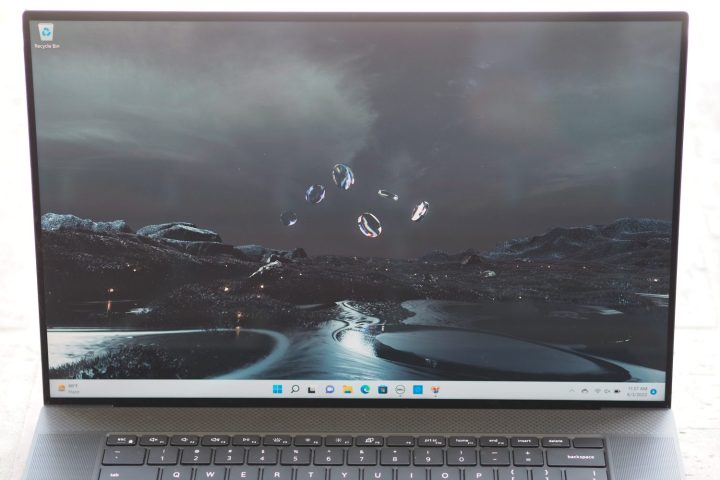 Mark Coppock/Digital Trends
Mark Coppock/Digital TrendsMy review unit was built around a 17-inch, 16:10 UHD+ IPS antireflective and anti-smudge touch display. There’s also a Full HD+ (1,920 x 1,200) option, but you’ll want the higher resolution given the larger panel. I found the display bright and colorful with deep blacks, although not the inky blacks of OLED screens.
I used my SpyderX colorimeter to test the display, and it passed with flying colors (no pun intended). It was very bright at 543 nits (300 nits is our baseline), making it bright enough to use outside. Its colors were wide at 100% of sRGB, 100% of AdobeRGB, and 98% of DCI-P3. They were also accurate at a DeltaE of 0.58 (less than 1.0 is considered excellent). And the contrast was 1,870:1, one of the highest scores we’ve seen in a laptop IPS display. It competes strongly with OLED displays in all but contrast, and it was by far the best IPS panel in our comparison group and one of the best IPS displays we’ve tested, period.
Creators crave a large, colorful, and accurate display, and the XPS 17 9720 delivers. Coupled with the laptop’s performance, the display makes for a highly portable creative workstation. Of course, it’s also great for productivity work and multimedia streaming.
| Brightness (nits) |
Contrast | sRGB gamut | AdobeRGB gamut | Accuracy DeltaE (lower is better) |
|
| Dell XPS 17 9720 (IPS) |
543 | 1,870:1 | 100% | 100% | 0.58 |
| Dell XPS 15 9520 (OLED) |
391 | 28,130:1 | 100% | 96% | 0.42 |
| LG Gram 17 (IPS) |
343 | 930:1 | 100% | 88% | 1.30 |
| Razer Blade 17 (IPS) |
313 | 890:1 | 100% | 90% | 0.84 |
| MSI Creator Z17 (IPS) |
355 | 840:1 | 100% | 87% | 1.35 |
 Mark Coppock/Digital Trends
Mark Coppock/Digital TrendsGrammy Award-winner Jack Joseph Puig tuned the quad-speaker setup, with Waves Nx technology providing 3D effects. Two speakers bracket the keyboard while two downward-firing speakers are located along each edge, and the results were excellent. There was a ton of volume, enough to be uncomfortable in my small home office. Mids and highs were clear, and there was more bass than usual. The XPS 17 9720 joins the XPS 15 9520 in offering the best audio you’ll find on a Windows laptop. Only Apple’s MacBook Pro is better.
Keyboard, touchpad, and webcam
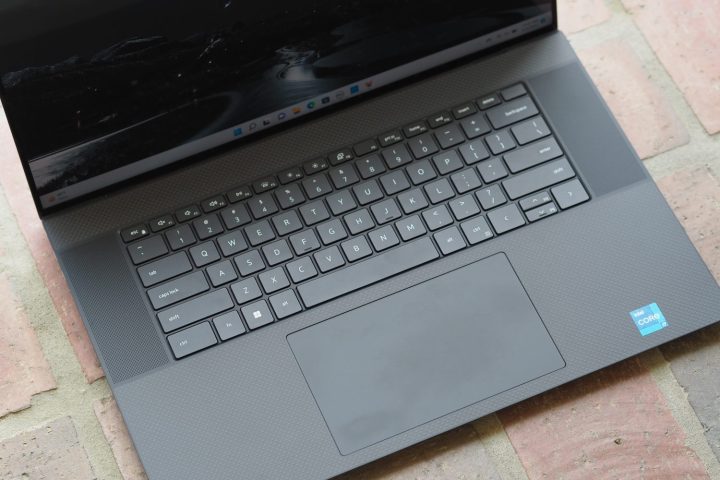 Mark Coppock/Digital Trends
Mark Coppock/Digital TrendsThe XPS 17 9720’s keyboard is centered in the keyboard deck between large speaker grilles and is the same size as the 15-inch model’s. That makes it seem small, but in fact, it provides large keycaps and plenty of key spacing. The switches have 1.3mm of travel, which isn’t a lot, but each keystroke has a satisfying snap that provides a precise and confident feel. It joins the rest of the XPS line and HP’s Spectres in having one of the best keyboards on a Windows laptop, with Apple’s Magic Keyboard on its most recent MacBooks being the only one that’s better.
The touchpad is expansive, with a smooth surface and quiet clicks. Windows 11 multitouch gestures work perfectly thanks to the Microsoft Precision touchpad drivers, and overall, it’s one of the better Windows touchpads I’ve used. Maybe someday Dell will upgrade to a haptic touchpad, which is well-executed on the MacBook line and keeps Apple in the lead. The display is touch-enabled and works perfectly.
Windows 11 Hello passwordless login is provided by a fingerprint reader conveniently located in the power button and an infrared camera for facial recognition. Both methods worked quickly and reliably.
Like the XPS 15 9520, the XPS 17 9720 now has separate webcam and infrared cameras. That’s meant to improve video quality, but Dell kept the resolution at 720p, which is behind the curve. The video quality was OK, but an upgrade to Full HD would have been appreciated.
Battery life
Powering a high-resolution 17-inch display and 45-watt CPU takes a lot of juice, and the XPS 17 9720 has the same 97 watt-hours of battery packed inside as did the XPS 17 9710. In terms of power consumption, the 12th-gen CPU is the only meaningful difference from the previous generation, so we should be able to gauge the new processor’s relative efficiency.
In our web browsing test that cycles through a series of popular and complex websites, the XPS 17 9720 lasted 7.5 hours, slightly less than average but more than two hours longer than the XPS 17 9710. The new model also lasted nearly three hours longer in our video test that loops a local Full HD Avengers trailer at 13 hours.
| Web browsing | Video | PCMark 10 Applications |
|
| Dell XPS 17 9720 (Core i7-12700H) |
7 hours, 36 minutes | 13 hours, 5 minutes | 7 hours, 3 minutes |
| Dell XPS 17 9710 (Core i7-11800H) |
5 hours, 4 minutes | 10 hours, 17 minutes | N/A |
| Dell XPS 15 9520 (Core i7-12700H) |
9 hours, 38 minutes | 12 hours, 40 minutes | 11 hours, 14 minutes |
| MSI Creator Z17 (Core i7-12700H) |
4 hours, 23 minutes | 4 hours, 32 minutes | N/A |
| Razer Blade 17 (Core i7-12800H) |
3 hours, 11 minutes | 3 hours, 41 minutes | N/A |
| LG Gram 16 2-in-1 (Core i7-1260P) |
11 hours, 31 minutes | 17 hours, 58 minutes | 16 hours, 39 minutes |
We didn’t test the previous-generation machine using PCMark 10’s Application battery benchmark, but the XPS 17 9720 managed seven hours. That’s again a bit less than average but still a decent score, indicating that the laptop may not make it through a full day of productivity tasks, but it will come close.
Battery life has improved significantly from the previous generation, and it’s just the slightest bit less than our laptop average. It’s solid battery life for such a large laptop with fast components, and the 12th-gen CPU does indeed seem to be more efficient.
Price and configurations
My review configuration was priced at $3,039 with a Core i7-12700H, 32GB of DDR5 RAM, a 1TB PCIe 4.0 solid-state drive (SSD), a 17-inch UHD+ display, and the Nvidia GeForce RTX 3060. The entry-level configuration is $1,839 for a Core i5-12500H, 8GB of RAM, a 512GB SSD, a 17-inch Full HD+ display, and Intel UHD integrated graphics. At the high end, you can spend $3,654 for a Core i9-12900HK, 64GB of RAM, a 2TB SSD, the 17-inch UHD+ display, and the RTX 3060. Of course, you can mix and match using Dell’s configurator and design exactly the right machine for you at the best price point. But regardless, the XPS 17 9720 is an expensive laptop.
Our take
The Dell XPS 17 (9720) maintains everything great about the previous model, including packing a massive display into about as small a chassis as is physically possible. It’s not quite the thinnest 17-inch laptop you can buy, nor is it the fastest. But it balances size and speed in a way that no other laptop does.
It’s also incredibly well-built, looks great, and even offers decent battery life. Toss in one of the best IPS displays we’ve tested, and you have a highly portable machine for creators, hardcore productivity workers, and multimedia consumers. It’s not cheap, but it’s well worth the price.
Are there any alternatives?
The MSI Creator Z17 is a recent addition to the 17-inch class, and it provides similar performance to the XPS 17 while being just a hair thinner. It doesn’t offer nearly as good a display, nor as much longevity, however, and it’s also an expensive machine.
Another alternative is the Razer Blade 17, which is just about as fast and almost as thin. But it, too, doesn’t offer the same kind of battery life, nor as good a display. It can be configured with a faster GPU, however, meaning it makes for a better gaming laptop.
The most competitive alternative is the 16-inch MacBook Pro, which has the performance, battery life, and display quality to move ahead of the XPS 17.
How long will it last?
The XPS 17 is solidly built and should last for years of typical abuse. It’s also well-stocked with up-to-date components, and you can upgrade the RAM yourself and add in a second SSD, further extending the machine’s life span. Of course, I don’t like the one-year warranty, but that’s, unfortunately, the industry standard.
Should you buy it?
Yes, if you need a large display with excellent performance in a reasonably sized chassis, then the XPS 17 is for you.

 Hollif
Hollif 